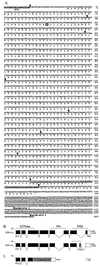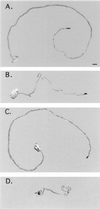A dynamin GTPase mutation causes a rapid and reversible temperature-inducible locomotion defect in C. elegans
- PMID: 9294229
- PMCID: PMC23381
- DOI: 10.1073/pnas.94.19.10438
A dynamin GTPase mutation causes a rapid and reversible temperature-inducible locomotion defect in C. elegans
Abstract
Drosophila shibire and its mammalian homologue dynamin regulate an early step in endocytosis. We identified a Caenorhabditis elegans dynamin gene, dyn-1, based upon hybridization to the Drosophila gene. The dyn-1 RNA transcripts are trans-spliced to the spliced leader 1 and undergo alternative splicing to code for either an 830- or 838-amino acid protein. These dyn-1 proteins are highly similar in amino acid sequence, structure, and size to the Drosophila and mammalian dynamins: they contain an N-terminal GTPase, a pleckstrin homology domain, and a C-terminal proline-rich domain. We isolated a recessive temperature-sensitive dyn-1 mutant containing an alteration within the GTPase domain that becomes uncoordinated when shifted to high temperature and that recovers when returned to lower temperatures, similar to D. shibire mutants. When maintained at higher temperatures, dyn-1 mutants become constipated, egg-laying defective, and produce progeny that die during embryogenesis. Using a dyn-1::lacZ gene fusion, a high level of dynamin expression was observed in motor neurons, intestine, and pharyngeal muscle. Our results suggest that dyn-1 function is required during development and for normal locomotion.
Figures






Similar articles
-
Differential expression and regulation of multiple dynamins.J Biol Chem. 1994 Feb 11;269(6):4547-54. J Biol Chem. 1994. PMID: 8308025
-
Dynamin II regulates hormone secretion in neuroendocrine cells.J Biol Chem. 2001 Feb 9;276(6):4251-60. doi: 10.1074/jbc.M006371200. Epub 2000 Oct 13. J Biol Chem. 2001. PMID: 11032832
-
The Eps15 C. elegans homologue EHS-1 is implicated in synaptic vesicle recycling.Nat Cell Biol. 2001 Aug;3(8):755-60. doi: 10.1038/35087075. Nat Cell Biol. 2001. PMID: 11483962
-
The function of dynamin in endocytosis.Curr Opin Neurobiol. 1995 Oct;5(5):559-65. doi: 10.1016/0959-4388(95)80059-x. Curr Opin Neurobiol. 1995. PMID: 8580706 Review.
-
Dynamin, a GTPase involved in the initial stages of endocytosis.Ciba Found Symp. 1993;176:185-93; discussion 193-7. doi: 10.1002/9780470514450.ch12. Ciba Found Symp. 1993. PMID: 8299419 Review.
Cited by
-
Lessons from Drosophila: Engineering Genetic Sexing Strains with Temperature-Sensitive Lethality for Sterile Insect Technique Applications.Insects. 2021 Mar 13;12(3):243. doi: 10.3390/insects12030243. Insects. 2021. PMID: 33805657 Free PMC article. Review.
-
Anti-aging treatments slow propagation of synucleinopathy by restoring lysosomal function.Autophagy. 2016 Oct 2;12(10):1849-1863. doi: 10.1080/15548627.2016.1207014. Epub 2016 Aug 2. Autophagy. 2016. PMID: 27485532 Free PMC article.
-
Beta-amyloid-induced dynamin 1 depletion in hippocampal neurons. A potential mechanism for early cognitive decline in Alzheimer disease.J Biol Chem. 2005 Sep 9;280(36):31746-53. doi: 10.1074/jbc.M503259200. Epub 2005 Jul 7. J Biol Chem. 2005. PMID: 16002400 Free PMC article.
-
A conserved role for SNX9-family members in the regulation of phagosome maturation during engulfment of apoptotic cells.PLoS One. 2011 Apr 8;6(4):e18325. doi: 10.1371/journal.pone.0018325. PLoS One. 2011. PMID: 21494661 Free PMC article.
-
Redundant and distinct functions for dynamin-1 and dynamin-2 isoforms.J Cell Biol. 1998 Dec 28;143(7):1871-81. doi: 10.1083/jcb.143.7.1871. J Cell Biol. 1998. PMID: 9864361 Free PMC article.
References
-
- Baba T, Damke H, Hinshaw J, Ikeda K, Schmid S L, Warnock D E. Cold Spring Harbor Symp Quant Biol. 1995;60:235–242. - PubMed
-
- Shpetner H S, Vallee R B. Cell. 1989;59:421–432. - PubMed
-
- Chen M S, Obar R A, Schroeder C C, Austin T W, Poodry C A, Wadsworth S C, Vallee R B. Nature (London) 1991;351:583–586. - PubMed
-
- van der Bliek A M, Meyerowitz E M. Nature (London) 1991;351:411–414. - PubMed
-
- Grigliatti T A, Hall L, Rosenbluth R, Suzuki D T. Mol Gen Genet. 1973;120:107–114. - PubMed
Publication types
MeSH terms
Substances
Associated data
- Actions
Grants and funding
LinkOut - more resources
Full Text Sources
Other Literature Sources
Molecular Biology Databases

